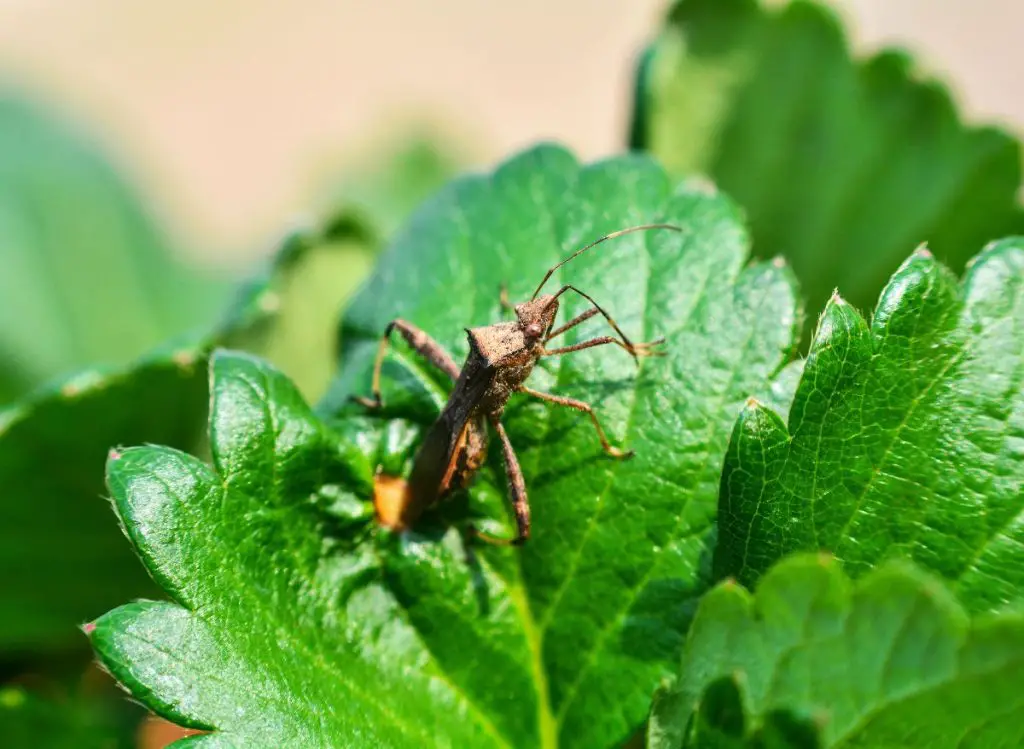This post contains affiliate links.

Growing your own strawberry plants is a fulfilling and rewarding experience for any gardener, but I know that it can be a frustrating experience to watch bugs infest your precious plants.
Pests sometimes can damage your beautiful strawberry patch and even ruin your entire crop if left unchecked. If you’re struggling to keep your strawberry plants healthy and pest-free, don’t worry! With the right strategies and techniques, it’s possible to eliminate bugs on strawberry plants and ensure a bountiful harvest.
Read on to find out some expert tips on how to get rid of bugs in strawberry plants so that you can enjoy sweet, juicy berries all season long. If ants are invading your strawberry plants and you are wondering how to keep them off your strawberry plants, I wrote a whole step-by-step process on how to keep ants off strawberry plants.
1- Identify the Types of Bugs Infesting Your Strawberry Plants
The first step to dealing with bugs on your strawberry plants is to determine the specific pests that are targeting your plants. Common bugs that attack strawberries include aphids, spider mites, slugs, and snails.
Developing a schedule to scout regularly for pests and beneficial insects is recommended, particularly at critical points in the season when each pest causes damage.
Each of these pests has a distinct appearance and feeding habit, so it’s important to correctly identify them before taking any control measures.
The table below contains the most common strawberry pests to look out for:
| Common Name | Scientific Name |
| Tarnished plant bug | Lygus lineolaris |
| Spotted wing drosophila | Drosophila suzukii |
| Cyclamen mites | Phytonemus pallidus (University of Florida) |
| Japanese beetle | Popillia japonica |
| Strawberry bud weevil | Anthonomus signatus |
| Two-spotted spider mite | Tetranychus urticae |
| Eastern flower thrips | Frankliniella tritici |
| Picnic beetle/sap beetle | Glischrochilus quadrisignatus (University of Florida) |
| Potato leafhopper | Empoasca fabae Harris (Oxford University Press) |
| Spittlebug | Cercopoidea |
| White grubs | Phyllophaga spp. |
| Strawberry leafroller | Ancylis comptana |
2- Clean and Maintain Your Garden
Prevention is always better than cure. By maintaining a clean garden and removing any debris or weeds that can harbor pests, you can avoid bug infestations. It is also important to keep the area around your strawberry plants free of any moisture and standing water, which can attract bugs like slugs and snails.
Additionally, maintaining your plants’ health by providing adequate water and nutrients can increase their resilience against pests because healthy plants are less likely to attract pests.
Moreover, experts from the University of California recommend soil preparation as an effective way to prevent bugs in strawberry plants.

3- Use Beneficial Insects
One of the best ways to get rid of pests on your strawberry plants is by using beneficial insects that will eat the harmful bugs. One of the best beneficial insects to use is ladybugs.
Ladybugs are natural predators of aphids, one of the most common pests on strawberry plants. You can buy ladybugs at garden centers or online and release them into your garden to get rid of pests naturally.
Beneficial insects, including predators and parasites, are essential to eliminate bugs in strawberry plants. Here is a list of the most common beneficial pests for strawberry plants:
- Assassin Bugs
- Centipedes
- Predatory Mites
- Six-spotted Thrips
- Lacewings and Ladybugs
- Parasitic Wasps
- Minute Pirate Bugs
4- Use Organic Remedies
You don’t need to use harsh chemicals to get rid of bugs in your strawberry plants. Instead, you can use natural, organic remedies that are safe for both your plants and the environment.
One of the cheapest ways is to use a mixture of water, vinegar, and dish soap, which acts as a pesticide that repels and eliminates bugs.
Another organic remedy is planting companion plants like garlic, chives, and marigolds around your strawberry plants. These plants act as natural repellents to insects.
5- Apply Neem Oil
Neem oil can be an effective, organic, natural solution that has been used for centuries to get rid of a wide range of pests. It works by disrupting the life cycle of the pest, preventing it from laying eggs and reproducing.
Neem oil is safe to use on strawberries and can be applied using a spray bottle.
Here is how to apply Neem Oil on your strawberry plants:
- Make a solution of neem oil and water.
- And apply it to your strawberry plants every 7-10 days for the best results.

6- Use Homemade Insecticidal Soap
Another effective way to eliminate pests on your strawberry plants is by using homemade insecticidal soap.
Homemade insecticidal soap is easy to make at home using simple ingredients like dish soap, oil, and water.
- Simply mix the ingredients together.
- And apply the solution to your plants using a spray bottle.
- The soap will kill the bugs on contact and can also help prevent new infestations from occurring.
7- Use Row Covers
If you are having trouble with pests like birds and squirrels eating your strawberries before you can harvest them, I encourage you to consider using row covers.
Row covers are made from a lightweight fabric that allows sunlight and air to enter while acting as physical barriers that prevent pests from accessing your plants. Simply place the cover over your plants, and secure it in place with stakes or rocks.
Using row covers will not only keep pests at bay but also help protect your plants from cold and harsh weather and other environmental factors that can damage them.

8- Rotating Plantings
Rotating plantings is an excellent way to get rid of bugs on strawberry plants because it can encourage the presence of beneficial insects. It is generally a good idea to rotate plantings with new plants at least every three years or when you notice that your plants become sensitive to pest attacks.
Generally, Sweet corn is known to be a good garden rotation for strawberries. On the other hand, it is recommended to avoid following crop plants that are sensitive to Verticillium wilts, including tomato, potato, eggplant, and cucurbit (Source: University of California)
8- Apply Insecticides
If organic remedies and preventive measures aren’t enough to control the bug problem on your strawberry plants, you can use insecticides as a last resort.
However, I recommend you always read and follow the instructions on the label carefully. Avoid applying insecticides during hot weather or when the strawberry plants are in full bloom to prevent them from affecting pollinators.
Also, keep in mind that repeated use of insecticides can lead to resistance and long-term harm to your plants.
What to read next:
- Are Ants Bad for Strawberry Plants? The Truth Behind the Myth
- When is the Best Time to Start Cucumber Seeds Indoors?
- Is Your Zucchini Turning Yellow and Rotting? (Here’s why!)
Wrapping Up
I believe that getting rid of bugs on strawberry plants can be a challenge, but it’s by no means impossible.
By using beneficial insects, neem oil, insecticidal soap, and good garden hygiene, you can help keep your plants healthy and pest-free.
And if you’re dealing with pests like birds and squirrels, row covers can be a lifesaver. With the helpful strategies outlined in this article, you can ensure a bountiful harvest of sweet, juicy strawberries that you can enjoy all summer long.

